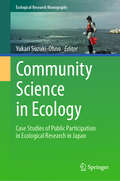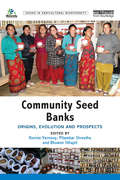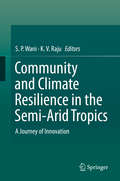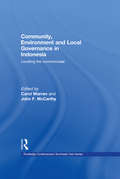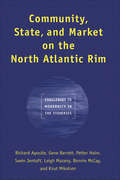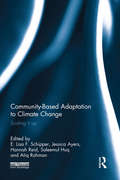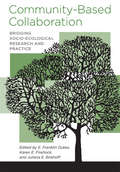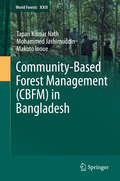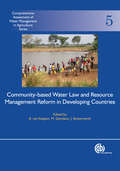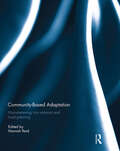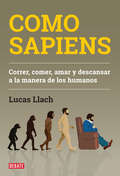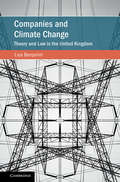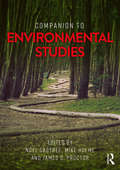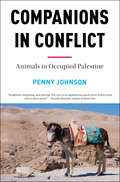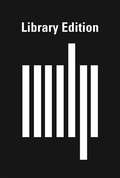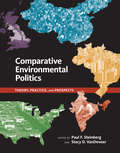- Table View
- List View
Community Science in Ecology: Case Studies of Public Participation in Ecological Research in Japan (Ecological Research Monographs)
by Yukari Suzuki-OhnoThis book introduces community science (or citizen science) projects in Japan with a focus on ecology. Environments and ecosystems that have been slowly built up over time are changing and collapsing dramatically. In this rapidly changing environment, ecologists need to collaborate with volunteers in their research and activities to investigate and conserve a vast area. This book aims to guide ecologists in the practice of community science. The authors, who are leading ecologists and practitioners of community science projects, share their methods and lessons learned from practice. The book begins with the definition of community science and the following chapters introduce monitoring in ecological community science, using various methods such as observation, specimens, photographs, videos, sounds, and environmental DNA. Readers can learn about the advantages and disadvantages of these methods in ecological community science monitoring. The book also coverstopics such as scientific communication, data obtained from ecological community science monitoring, the rights of participants, decision-making in community science, and conservation activities with volunteers such as invasive alien species extermination and nature restoration. This book serves as a valuable resource for readers interested in ecological community science and its practice. The book is suitable for both undergraduate students and researchers as well as practitioners.
Community Seed Banks: Origins, Evolution and Prospects (Issues in Agricultural Biodiversity)
by Bhuwon Sthapit Ronnie Vernooy Pitambar ShresthaCommunity seed banks first appeared towards the end of the 1980s, established with the support of international and national non-governmental organizations. This book is the first to provide a global review of their development and includes a wide range of case studies. Countries that pioneered various types of community seed banks include Bangladesh, Brazil, Ethiopia, India, Nepal, Nicaragua, the Philippines and Zimbabwe. In the North, a particular type of community seed bank emerged known as a seed-savers network. Such networks were first established in Australia, Canada, the UK and the USA before spreading to other countries. Over time, the number and diversity of seed banks has grown. In Nepal, for example, there are now more than 100 self-described community seed banks whose functions range from pure conservation to commercial seed production. In Brazil, community seed banks operate in various regions of the country. Surprisingly, despite 25 years of history and the rapid growth in number, organizational diversity and geographical coverage of community seed banks, recognition of their roles and contributions has remained scanty. The book reviews their history, evolution, experiences, successes and failures (and reasons why), challenges and prospects. It fills a significant gap in the literature on agricultural biodiversity and conservation, and their contribution to food sovereignty and security.
Community Snowman
by Deborah KerbelBuilding a snowman becomes a community effort, in this wordless story about a cold winter day that snowballs into a warm neighborhood gathering. One morning, a girl wakes up to discover that it has snowed overnight. After breakfast she starts building a snowman — and soon realizes that it’s easier and more fun to do with some help! Other kids join in to help roll the balls that make up the snowman’s body. A passing teenager helps them reach to place the head. Then more neighbors come along and each contribute something unique from their packed lunches or winter ensembles: a pickle for a nose, bagel halves for the ears, lychee buttons, a shawl … The final touch comes in the form of a poppy pin placed by a veteran over the snowman’s heart. The snowman smiles as the community members pause to admire their work. And when the crowd disperses, the girl and her grandfather stay behind to share a snack and warmth with someone who needs them. Inspired by a real “community snowman” built by neighbors, author Deborah Kerbel has crafted a narrative about serendipitous connections, working together and paying it forward. These themes — and more! — are brought to life by the comic brilliance of Tine Modeweg-Hansen. Key Text Features wordless panels illustrations Correlates to the Common Core State Standards in English Language Arts: CCSS.ELA-LITERACY.RL.1.3 Describe characters, settings, and major events in a story, using key details. CCSS.ELA-LITERACY.RL.1.7 Use illustrations and details in a story to describe its characters, setting, or events.
Community Vision and Leadership in Practice: A Sustainable Approach (Social-Environmental Sustainability)
by Chris Maser Holly V. CampbellThis book is about building and maintaining involved, sustainable, and inclusive communities from the ground up during a period of unprecedented growth and global change. It explains the concepts and principles of community and sustainability and provides students with a framework of sustainable community planning to put into practice. It is also designed to help communities everywhere identify and reconnect the true essence of their ecological setting with the objective of raising their quality of life by increasing social, environmental, and economic sustainability. Features: Provides up-to-date frameworks for sustainable community planning processes and case studies on community planning Explains tools for sustainable planning in accessible (non-specialist) language Illustrates a roadmap to an inclusive, collaborative future Explains aspects of sustainable community planning to maximize ecological ecosystem services and climate co-benefits simultaneously Includes discussion questions and suggestions following each chapter Intended for undergraduate and graduate students taking leadership and community courses with an emphasis on sustainable practices and ethics, as well as for citizens and professionals involved in community projects related to sustainability, the authors provide a forward-thinking approach, showing readers that they are capable of making a positive impact on the future of community development through sustainable approaches and ethical leadership practices.
Community and Climate Resilience in the Semi-Arid Tropics: A Journey of Innovation
by K. V. Raju S. P. WaniThis book focuses on developing an integrated holistic approach for harnessing the potential of rain-fed agriculture. In this approach, rainwater management through harvesting and recharging the groundwater is used as an entry point activity for increasing the productivity for farmers through enhanced water use efficiency. To provide the holistic and integrated solutions, the approach of consortium through building partnerships with different stakeholders, eg. different research institutions (State, National and International), development departments, eg. Department of Agriculture, Department of Animal Husbandry etc., Non-Government Organizations (NGOs), Farmers Organizations Community-based Organizations (CBOs) along with market linkages through private companies.
Community, Environment and Local Governance in Indonesia: Locating the commonweal (Routledge Contemporary Southeast Asia Series)
by Carol Warren John F. McCarthyThis book explores the forces reconfiguring local resource governance in Indonesia since 1998, drawing together original field research undertaken in a decade of dramatic political change. Case studies from across Indonesia’s diverse cultural and ecological landscapes focus on the most significant resource sectors – agriculture, fisheries, forestry, mining and tourism –providing a rare in-depth view of the dynamics shaping social and environmental outcomes in these varied contexts. Debates surrounding the ‘tragedy of the commons’ and environmental governance have focused on institutional considerations of how to craft resource management arrangements in order to further the policy objectives of economic efficiency, social equity and environmental sustainability. The studies in this volume reveal the complexity of resource security issues affecting local communities and user groups in Indonesia as they engage with wider institutional frameworks in a context driven simultaneously by decentralizing and globalizing forces. Through ground up investigations of how local groups with different cultural backgrounds and resource bases are responding to the greater autonomy afforded by Indonesia’s new political constellation, the authors appraise the prospects for rearticulating governance regimes toward a more equitable and sustainable ’commonweal’. This volume offers valuable insights into questions of import to scholars as well as policy-makers concerned with decentralized governance and sustainable resource management.
Community, State, and Market on the North Atlantic Rim: Challenges to Modernity in the Fisheries
by Bonnie Mccay Svein Jentoft Gene Barrett Knut Mikalsen Leigh Mazany Petter Holm Richard ApostleThis is a study of Northern Norway and Atlantic Canada, two regions experiencing a severe crisis due to overexploitation of fisheries resources. The work of a group of researchers from Canada, Norway, and the United States, it examines the implications of common market integration, privatized resource management, and small business development policies for fishery-dependent communities in terms of long-term sustainability and participatory democracy. The book is broken into three sections: an examination of the economic and institutional history of the fisheries in Norway and Atlantic Canada, a study of the regulatory regimes used in the fisheries of these two regions, and an analysis of reactions in three communities, two in Canada and one in Norway, to the decline and collapse of fish stocks. Comparative, multidisciplinary, and multinational in approach, it is a major contribution to the literature on fishing regulations, the role of the state, and resource development in the North Atlantic.
Community-Based Adaptation to Climate Change: Scaling it up
by Hannah Reid Saleemul Huq E. Lisa F. Schipper Jessica Ayers Atiq RahmanAs climate change adaptation rises up the international policy agenda, matched by increasing funds and frameworks for action, there are mounting questions over how to ensure the needs of vulnerable people on the ground are met. Community-based adaptation (CBA) is one growing proposal that argues for tailored support at the local level to enable vulnerable people to identify and implement appropriate community-based responses to climate change themselves. Community Based Adaptation to Climate Change: Scaling it up explores the challenges for meeting the scale of the adaptation challenge through CBA. It asks the fundamental questions: How can we draw replicable lessons to move from place-based projects towards more programmatic adaptation planning? How does CBA fit with larger scale adaptation policy and programmes? How are CBA interventions situated within the institutions that enable or undermine adaptive capacity? Combining the research and experience of prominent adaptation and development theorists and practitioners, this book presents cutting edge knowledge that moves the debate on CBA forward towards effective, appropriate, and ‘scaled-up’ adaptive action.
Community-Based Collaboration: Bridging Socio-Ecological Research and Practice
by Juliana E. Birkhoff E. Franklin Dukes Karen E. FirehockThe debate over the value of community-based environmental collaboration is one that dominates current discussions of the management of public lands and other resources. In Community-Based Collaboration: Bridging Socio-Ecological Research and Practice, the volume's contributors offer an in-depth interdisciplinary exploration of what attracts people to this collaborative mode. The authors address the new institutional roles adopted by community-based collaborators and their interaction with existing governance institutions in order to achieve more holistic solutions to complex environmental challenges. Contributors:Heidi L. Ballard, University of California, Davis * Juliana E. Birkhoff, RESOLVE * Charles Curtin, Antioch University * Cecilia Danks, University of Vermont * E. Franklin Dukes, University of Virginia and George Mason University * María Fernández-Giménez, Colorado State University * Karen E. Firehock, University of Virginia * Melanie Hughes McDermott, Rutgers University * William D. Leach, California State University, Sacramento * Margaret Ann Moote, private consultant * Susan L. Senecah, State University of New York College of Environmental Science and Forestry * Gregg B. Walker, Oregon State University
Community-Based Forest Management (World Forests #22)
by Tapan Kumar Nath Mohammed Jashimuddin Makoto InoueThe book is immensely beneficial to the readers to have a clear understanding of various CBFM practices prevailing in Bangladesh. Providing a comprehensive and critical analysis of success stories concerning several CBFM practices in different forest areas of Bangladesh, together with their respective strengths and weaknesses, it identifies sharing authority to take decision by the community as one of the main weaknesses. The other main weakness is the lack of beat level authority to coordinate with community for making the process vibrant. The book determines that it is the community patrol group which is most effective under the co-management system, yet the general body and executive committee of the co-management system are composed of different stakeholders, each of which is subject to their own work pressures, and are not as effective as claimed. There is a need to empower communities living in and around forests, and to create ownership of the forests so that they can feel that the forests around them are by the community and for the community.
Community-based Water Law and Water Resource Management Reform in Developing Countries
by B. C. P. van Koppen Mark Giordano John ButterworthContributors from various specialties of engineering and of social science analyze operating community-based water laws in Africa, Latin America, and Asia; and critically examine the interface between community-based water laws, formal water laws, and a variety of other institutional dimensions in ongoing water resource management reform. Most of the 15 studies were selected from presentations to a January 2005 international conference in Johannesburg, which focused on rural Africa. Annotation ©2008 Book News, Inc. , Portland, OR (booknews.com)
Community-based adaptation: Mainstreaming into national and local planning
by Hannah ReidCommunity-based adaptation (CBA) to climate change is based on local priorities, needs, knowledge and capacities. Early CBA initiatives were generally implemented by non-government organisations (NGOs), and operated primarily at the local level. Many used ‘bottom-up’ participatory processes to identify the climate change problem and appropriate responses. Small localised stand-alone initiatives are insufficient to address the scale of challenges climate change will bring, however. The causes of vulnerability - such as market or service access, or good governance - also often operate beyond the project level. Larger organisations and national governments have therefore started to implement broader CBA programmes, which provide opportunities to scale up responses and integrate CBA into higher levels of policy and planning. This book shows that it is possible for CBA to remain centred on local priorities, but not necessarily limited to work implemented at the local level. Some chapters address the issue of mainstreaming CBA into government policy and planning processes or into city or sectoral level plans (e.g. on agriculture). Others look at how gender and children’s issues should be mainstreamed into adaptation planning itself, and others describe how tools can be applied, and finance delivered for effective mainstreaming.This book was published as a special issue of Climate and Development.
Como funciona la biologia (How Biology Works)
by DKDescubre todo lo que necesitas saber sobre las ciencias de la vida sin engaños. ¿Cómo actúan las vacunas? ¿Qué hace diferentes a las células madre? ¿Lograremos clonar a los dinosaurios? Entender algunos conceptos de la biología no es tarea fácil y a menudo, resulta complicado diferenciar la "buena ciencia” (informativa, objetiva y verificable) de la "mala ciencia”. Adéntrate en este libro de ciencias y encuentra: Conceptos complejos de la biología, como en qué consiste la terapia génica o que se está logrando con la investigación de células madre, explicados con texto simple y gráficos claros. Una introducción para principiantes en la que se explican conceptos y fundamentos básicos, como la estructura de las células, las bacterias o las capas de la biosfera.Diagramas, imágenes e infografías que te ayudarán a entender las explicaciones más rápidamente y de manera visual. Datos fascinantes y respuestas a las preguntas más importantes de la biología.Materiales de apoyo para complementar tus estudios que cubren los temas de la materia de biologíaCómo funciona la biología te muestra todo lo que necesitas saber sobre la ciencias de la vida con un enfoque práctico y muy visual, desde el ciclo de vida de los seres vivos y la genética hasta los últimos descubrimientos de la biotecnología y la tecnología médica. Este libro de ciencia pertenece a la colección de DK How it Works en español, que explica temas complejos de forma clara y visual a través de infografías, textos sencillos e información fácil de entender tanto para estudiantes como para lectores generales que quieran ampliar sus conocimientos.--------------------------------------Discover everything you need to know about biology. How do vaccines work? What is special about stem cells? How did we evolve from bacteria? The science of life can be daunting, and it can be hard to separate “good” science from “bad.” How Biology Works brings you the facts visually explained.With this simple science book, you can find: An introduction to complex concepts and new ideas for beginners A systematic layout of text and graphics to make Biology more approachable Different materials, diagrams, and theories to supplement studies A practical, no-nonsense approach assisting you with understanding the fundamentals of Biology Find chapters that outline different subject matters and ideas such as evolution, biology of cells/how cells work, biotechnology, and medical technology.
Como sapiens: Correr, comer, amar y descansar a la manera de los humanos
by Lucas LlachEl conflicto entre nuestros instintos y cuerpo de Homo sapiens y la vida que llevamos es cada vez mayor. ¿Qué humanidad estamos construyendo? Nuestra especie no era la única ni la más prometedora de las varias versiones de humanos en el planeta hace 200.000 años. Pero lo conquistó. Salió de su cuna en África y ocupó todos los continentes. Seleccionó y rediseñó al puñado de animales y vegetales de los que se alimenta. Se multiplicó una y mil veces. Hizo pueblos, ciudades, imperios, guerras, transportes, fábricas e ideas, muchas ideas. El Homo sapiens de hoy es el mismo animal, pero se mueve menos, come peor, trabaja más y tiene menos sexo que sus tatarabuelos africanos. Padece ese desfasaje a cambio de mortalidad baja y pobreza en descenso. Sigue triunfando en su primacía sobre el resto de las especies, pero lo pueden desafiar seriamente una pandemia o una crisis ecológica, o los cambios en su propio cuerpo a medida que la medicina apaga la selección natural y la ingeniería genética imagina humanos de diseño. A prudente distancia de la corrección política y con una dosis importante de humor, este ensayo -que es también crónica- repasa los hallazgos de los últimos años sobre la evolución humana e invita a pensar cómo queremos vivir de ahora en adelante. "Que una especie intente desactivar los mecanismos de la selección natural que operan sobre sí misma, y lo logre casi por completo, es inédito, y ya está redefiniendo al Homo sapiens [...] El ser humano se va convirtiendo gradualmente en Homo medicus, una especie mucho más diversa, formada por descendientes de Homo sapiens que van acumulando variaciones genéticas, útiles o no. Gracias a la medicina, los Homo medicus pueden sobrevivir a los errores de copia, y a su vez necesitan cada vez más de la medicina para que emparche lo que ya no limpia de manera más eficaz y mucho más cruel la selección natural. [...] Pero también es cierto que podemos tratar de moderar esos desequilibrios entre lo que somos y la vida que llevamos. Vivir como sapiens no es volver a ningún tiempo ni lugar específicos. Es tratar de ser conscientes de que somos Homo sapiens (casi iguales, biológicamente, a los de hace cien siglos) nacidos en una cultura para la que el Homo sapiens no está preparado".
Companies and Climate Change: Theory and Law in the United Kingdom (Cambridge Studies on Environment, Energy and Natural Resources Governance)
by Lisa BenjaminCompanies lie at the heart of the climate crisis and are both culpable for, and vulnerable to, its impacts. Rising social and investor concern about the escalating risks of climate change are changing public and investor expectations of businesses and, as a result, corporate approaches to climate change. Dominant corporate norms that put shareholders (and their wealth maximization) at the heart of company law are viewed by many as outdated and in need of reform. Companies and Climate Change analyzes these developments by assessing the regulation and pressures that impact energy companies in the UK, with lessons that apply worldwide. In this work, Lisa Benjamin shows how the Paris Agreement, climate and energy law in the EU and the UK, and transnational human rights and climate litigation, are regulatory and normative developments that illustrate how company law can and should act as a bridge to progressive corporate climate action.
Companion to Environmental Studies
by Mike Hulme Noel Castree James D. ProctorCompanion to Environmental Studies presents a comprehensive and interdisciplinary overview of the key issues, debates, concepts, approaches and questions that together define environmental studies today. The intellectually wide-ranging volume covers approaches in environmental science all the way through to humanistic and post-natural perspectives on the biophysical world. Though many academic disciplines have incorporated studying the environment as part of their curriculum, only in recent years has it become central to the social sciences and humanities rather than mainly the geosciences. ‘The environment’ is now a keyword in everything from fisheries science to international relations to philosophical ethics to cultural studies. The Companion brings these subject areas, and their distinctive perspectives and contributions, together in one accessible volume. Over 150 short chapters written by leading international experts provide concise, authoritative and easy-to-use summaries of all the major and emerging topics dominating the field, while the seven part introductions situate and provide context for section entries. A gateway to deeper understanding is provided via further reading and links to online resources. Companion to Environmental Studies offers an essential one-stop reference to university students, academics, policy makers and others keenly interested in ‘the environmental question’, the answer to which will define the coming century.
Companions in Conflict: Animals in Occupied Palestine
by Penny JohnsonAn award-winning author explores the Israeli-Palestinian conflict through a surprising lens: the animals trying to survive in occupied hotspotsIn August of 2016, Israeli police officers arrested a Palestinian donkey in the Jordan Valley. The charge? Not having the correct paperwork.It's an image as sad (and strangely common) as it is symbolic: No creature great or small is free from the absurdities of the Occupied Territories. Companions in Conflict is a surprising investigation into the deeply intertwined lives of the region's human and animal populations: From camel beauty contests, to a herd of "illegal" Palestinian cows hunted down by Israeli soldiers; from a hyena in a wolf pack that becomes a symbol of Middle East peace, to the tragic story of the now-taxidermied inhabitants of the West Bank's only zoo--who were frightened to death by Israeli explosive devices. Drawing on three decades of living in the region, Penny Johnson's insightful writing reveals what these and many other animals' fates tell us about the current state of Israel and Palestine. What's more, looking forward, she introduces a new generation of environmental activists to us, who represent the region's best hope for conservation, collaboration, and justice for all creatures.
Comparative Environmental Politics
by Stacy D. Vandeveer Paul F. SteinbergHow do different societies respond politically to environmental problems around the globe? Answering this question requires systematic, cross-national comparisons of political institutions, regulatory styles, and state-society relations. The field of comparative environmental politics approaches this task by bringing the theoretical tools of comparative politics to bear on the substantive concerns of environmental policy. This book outlines a comparative environmental politics framework and applies it to concrete, real-world problems of politics and environmental management. After a comprehensive review of the literature exploring domestic environmental politics around the world, the book provides a sample of major currents within the field, showing how environmental politics intersects with such topics as the greening of the state, the rise of social movements and green parties, European Union expansion, corporate social responsibility, federalism, political instability, management of local commons, and policymaking under democratic and authoritarian regimes. It offers fresh insights into environmental problems ranging from climate change to water scarcity and the disappearance of tropical forests, and it examines actions by state and nonstate actors at levels from the local to the continental. The book will help scholars and policymakers make sense of how environmental issues and politics are connected around the globe, and is ideal for use in upper-level undergraduateand graduate courses.
Comparative Environmental Politics: Theory, Practice, and Prospects (American and Comparative Environmental Policy)
by Stacy D. VanDeveer edited by Paul F. SteinbergCombining the theoretical tools of comparative politics with the substantive concerns of environmental policy, experts explore responses to environmental problems across nations and political systemsHow do different societies respond politically to environmental problems around the globe? Answering this question requires systematic, cross-national comparisons of political institutions, regulatory styles, and state-society relations. The field of comparative environmental politics approaches this task by bringing the theoretical tools of comparative politics to bear on the substantive concerns of environmental policy. This book outlines a comparative environmental politics framework and applies it to concrete, real-world problems of politics and environmental management.After a comprehensive review of the literature exploring domestic environmental politics around the world, the book provides a sample of major currents within the field, showing how environmental politics intersects with such topics as the greening of the state, the rise of social movements and green parties, European Union expansion, corporate social responsibility, federalism, political instability, management of local commons, and policymaking under democratic and authoritarian regimes. It offers fresh insights into environmental problems ranging from climate change to water scarcity and the disappearance of tropical forests, and it examines actions by state and nonstate actors at levels from the local to the continental. The book will help scholars and policymakers make sense of how environmental issues and politics are connected around the globe, and is ideal for use in upper-level undergraduateand graduate courses.
Comparative Perspectives on Communal Lands and Individual Ownership: Sustainable Futures
by Lee GoddenComparative Perspectives on Communal Lands and Individual Ownership: Sustainable Futures addresses property and land title as central mechanisms governing access to communally-held land and resources. The collection assesses the effectiveness of property law and tenure models developed around concepts of individual ownership, for achieving long-term environmental and economic sustainability for indigenous peoples and local communities. It explores the momentum for change in the international realm, and then develops a comparative focus across Australia, North America, Africa, Peru, New Zealand and the Pacific region, examining the historical and current impacts of individuation of title on the customary law and practice of indigenous peoples and local communities. Themes of property, privatisation and sustainable communities are developed in theoretical analyses and case studies from these jurisdictions. The case studies throw into sharp relief how questions of land law and resources management should not be separated from wider issues about the long-term viability of communities. Comparative analysis allows consideration of how western models of land tenure and land title might better accommodate the exercise of traditional practices of indigenous peoples and local communities, while still promoting autonomy, choice and economic development. This volume will be of interest to scholars and professionals working in the fields of property law, land reform, policy and planning, indigenous law and customary law, environmental sustainability, development and resource management.
Comparative Perspectives on Environmental Policies and Issues (Routledge Research in Environmental Policy and Politics)
by Robert DibieComparative Perspectives on Environmental Policies and Issues presents tools and concepts about environmental policies in several developed and developing countries. It explores a broad survey of ecological modernization theory, ecological feminism theory, environmental justice theory, the concept of sustainability, and research on environmental policies. Data were collected through surveys, interviews, and focus groups, and are used to analyze social, economic, and environmental impact on people. The book specifically discusses how the earth’s basic life-supporting capital (soils, forests, species, fresh water and oceans) is degraded or depleted to provide for human needs, and how air pollution and acid precipitation, are causing widespread injury to humans, forests, and crops. Realistically, over-taxing of natural resources and ecological systems throughout the world has promoted economic growth and created increasing opportunities for people while also advancing social injustice. The use of the environment to accomplish social and economic transformation raises fundamental issues for the study of environmental policy and the natural ecological system. As human beings exploit the natural environment to meet present needs, they often will destroy resources needed for the future generations. Thus, environmental policies are enacted to ensure that social and economic impacts of the environment are compatible with the limits of natural systems. Offering an intuitive and crystal-clear explanation of the key concepts and principles of environmental policies and sustainable development, this volume is suitable not only for environmental science students, but also for instructors, practitioners, researchers, and academics.
Comparative Plant Succession among Terrestrial Biomes of the World (Ecology, Biodiversity and Conservation)
by Lawrence R. Walker Karel PrachDespite a century of study by ecologists, recovery following disturbances (succession) is not fully understood. This book provides the first global synthesis that compares plant succession in all major terrestrial biomes and after all major terrestrial disturbances. It asks critical questions such as: Does succession follow general patterns across biomes and disturbance types? Do factors that control succession differ from biome to biome? If common drivers exist, what are they? Are they abiotic or biotic, or both? The authors provide insights on broad, generalizable patterns that go beyond site-specific studies, and present discussions on factors such as varying temporal dynamics, latitudinal differences, human-caused vs. natural disturbances, and the role of invasive alien species. This book is a must-read for researchers and students in ecology, plant ecology, restoration ecology and conservation biology. It also provides a valuable framework to aid land managers attempting to manipulate successional recovery following increasingly intense and widespread human-made disturbances.
Comparative Renewables Policy: Political, Organizational and European Fields (Routledge Studies on the Governance of Sustainability in Europe)
by Jørgen Wettestad Elin Lerum Boasson Merethe Dotterud LeirenChallenging one-eyed technology-focused accounts of renewables policy, this book provides a ground-breaking, deep-diving and genre-crossing longitudinal study of policy development. The book develops a multi-field explanatory approach, capturing inter-relationships between actors often analyzed in isolation. It provides empirically rich and systematically conducted comparative case studies on the political dynamics of the ongoing energy transition in six European countries. While France, Germany, Poland and the United Kingdom opted for ‘technology-specific’ renewables support mixes, Norway and Sweden embarked on ‘technology-neutral’ support mixes. Differences between the two groups result from variations in domestic political and organizational fields, but developments over time in the European environment also spurred variation. These findings challenge more simplistic and static accounts of Europeanization. This volume will be of key interest to scholars and students of energy transitions, comparative climate politics, policy theory, Europeanization, European integration and comparative European politics more broadly, as well practitioners with an interest in renewable energy and climate transition. The Open Access version of this book, available at: https://www.taylorfrancis.com/books/e/9780429198144, has been made available under a Creative Commons Attribution-Non Commercial-No Derivatives 4.0 license.
Comparing Futures for the Sacramento-San Joaquin Delta
by Jay R. Lund Ellen Hanak William E. Fleenor William A. Bennett Richard E. Howitt Jeffrey F. Mount Peter B. MoyleWritten by a team of independent water experts, this analysis of the latest data evaluates proposed solutions to the Sacramento-San Joaquin Delta's myriad problems. The authors find the current policy unsustainable and suggest a suitable strategy.
Comparisons in Resource Management: Six Notable Programs in Other Countries and Their Possible U.S. Application (RFF Natural Resource Management Set)
by Henry JarrettOriginally presented as public lectures in the 1961 Resources for the Future Forum on Comparative Resources Policy and Administration. Originally published in 1961
